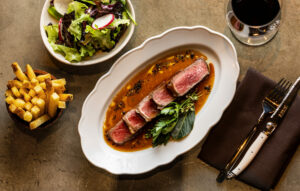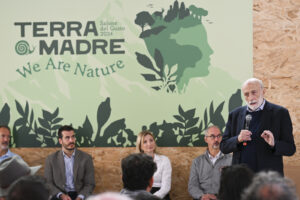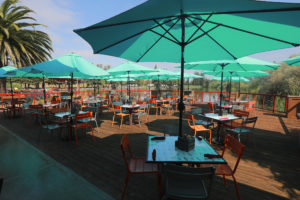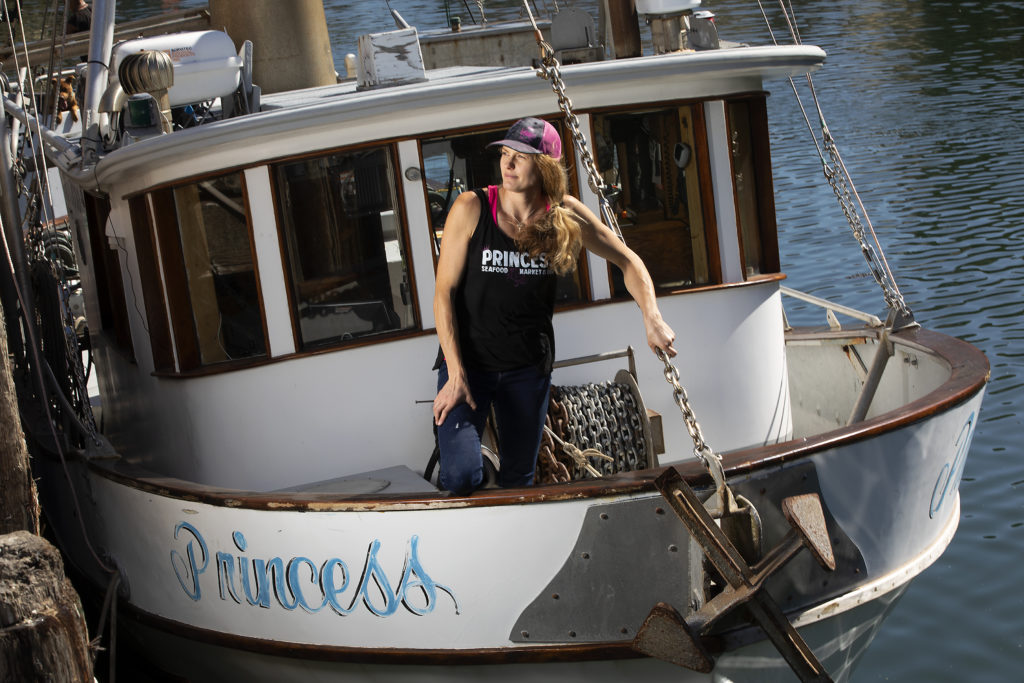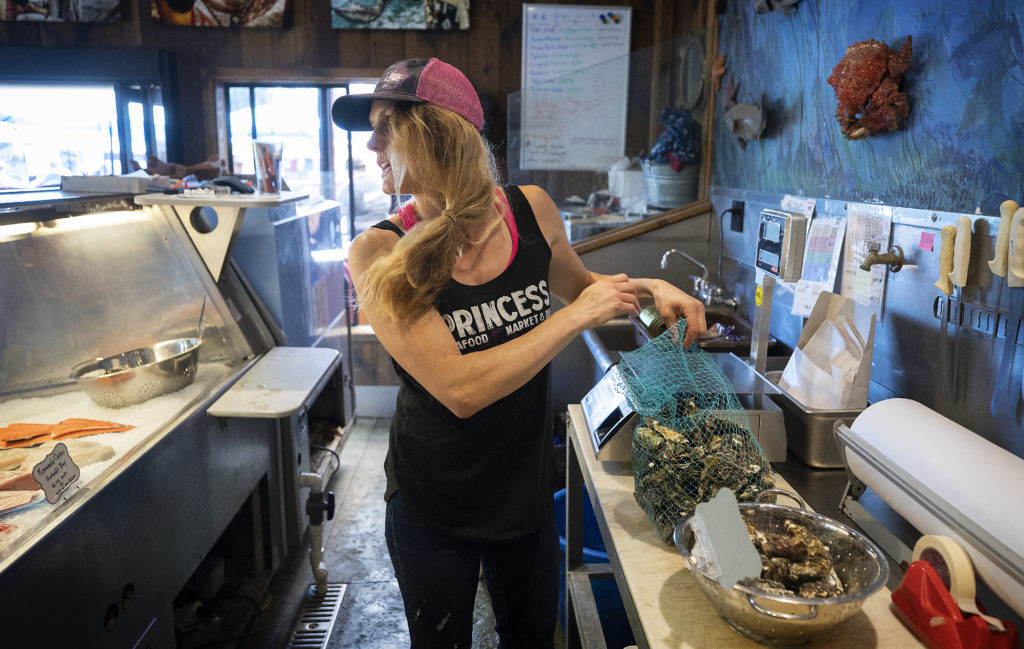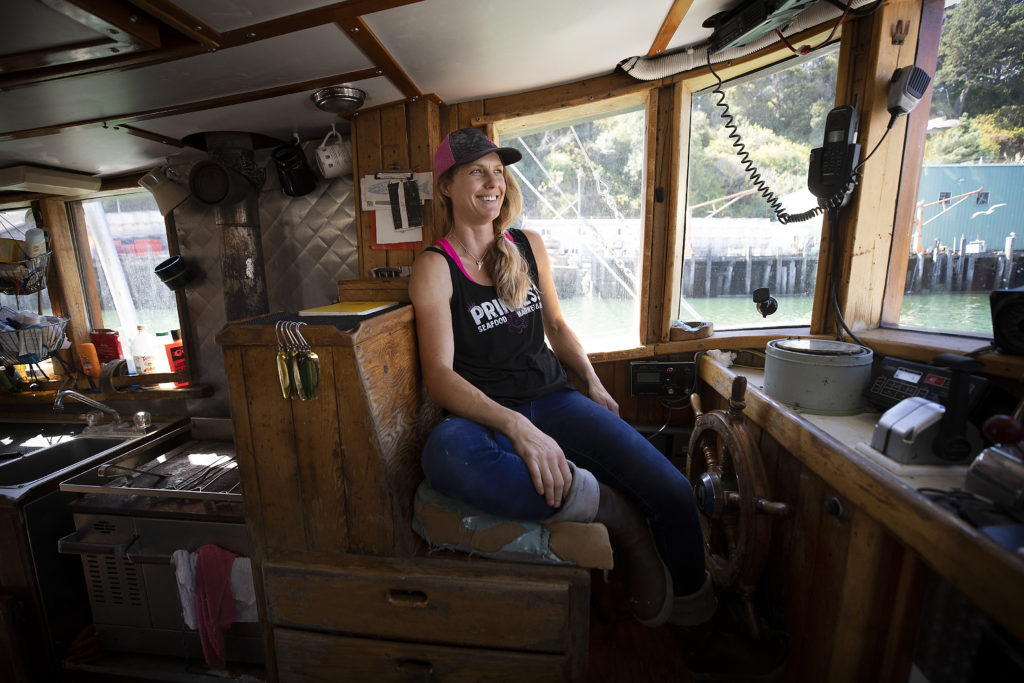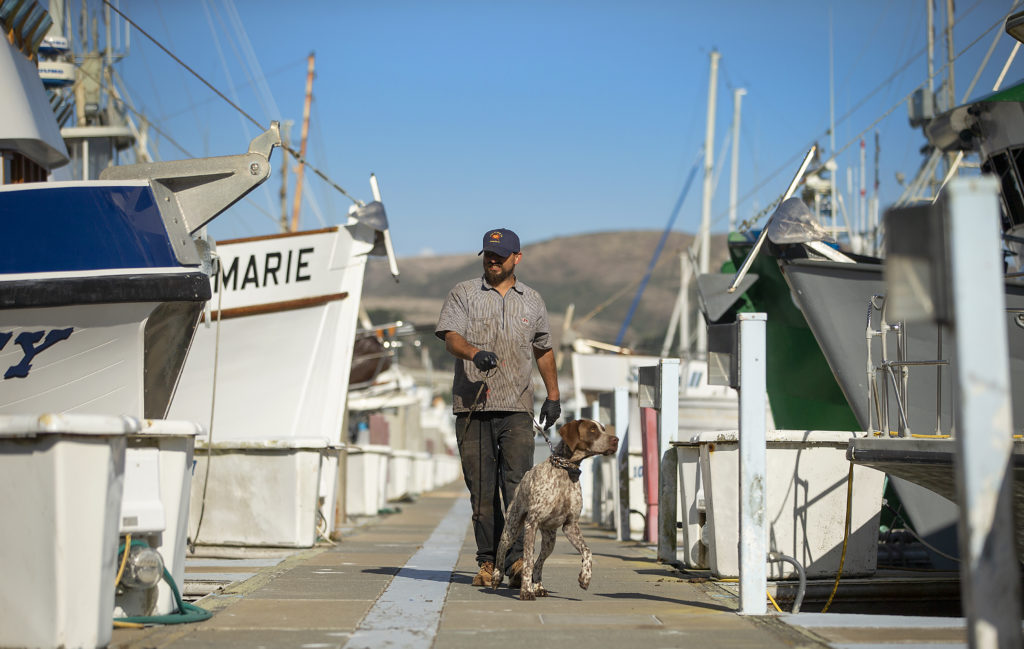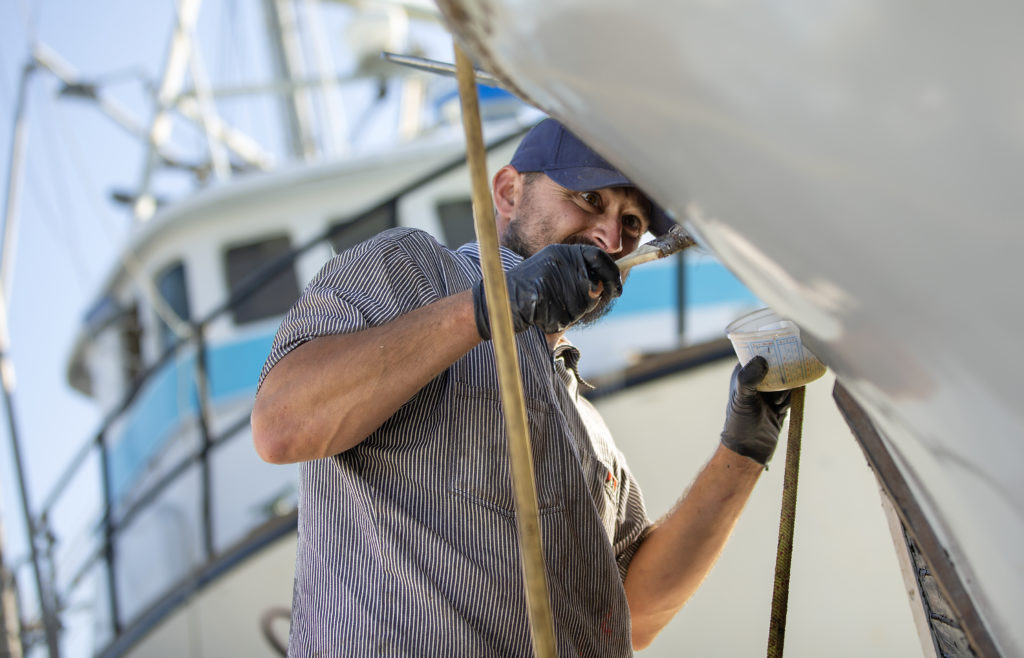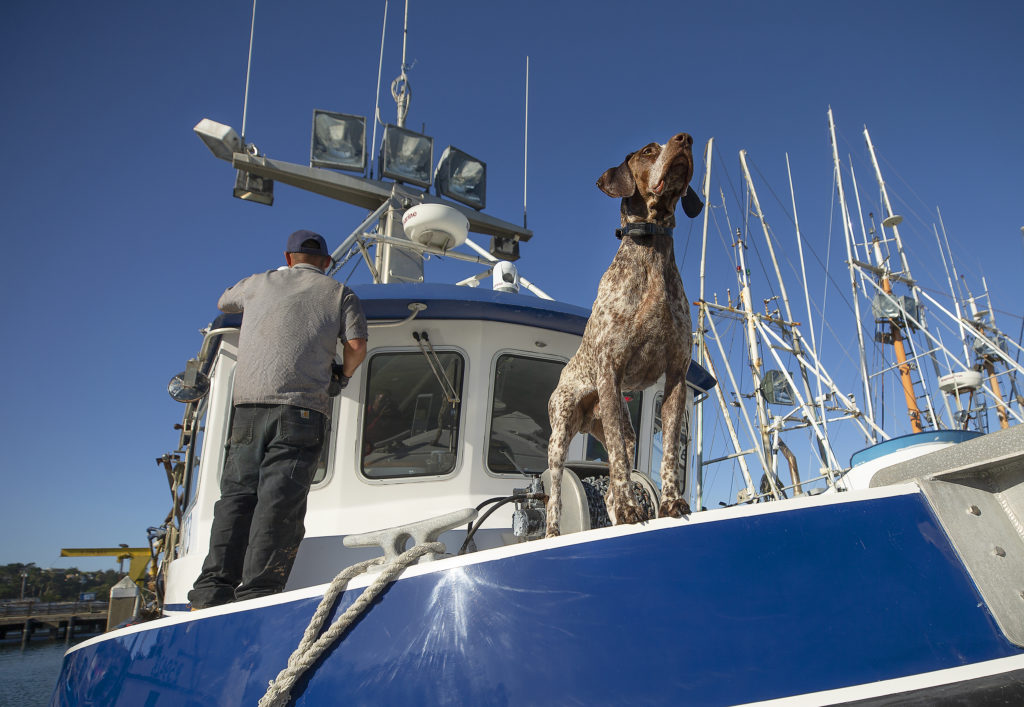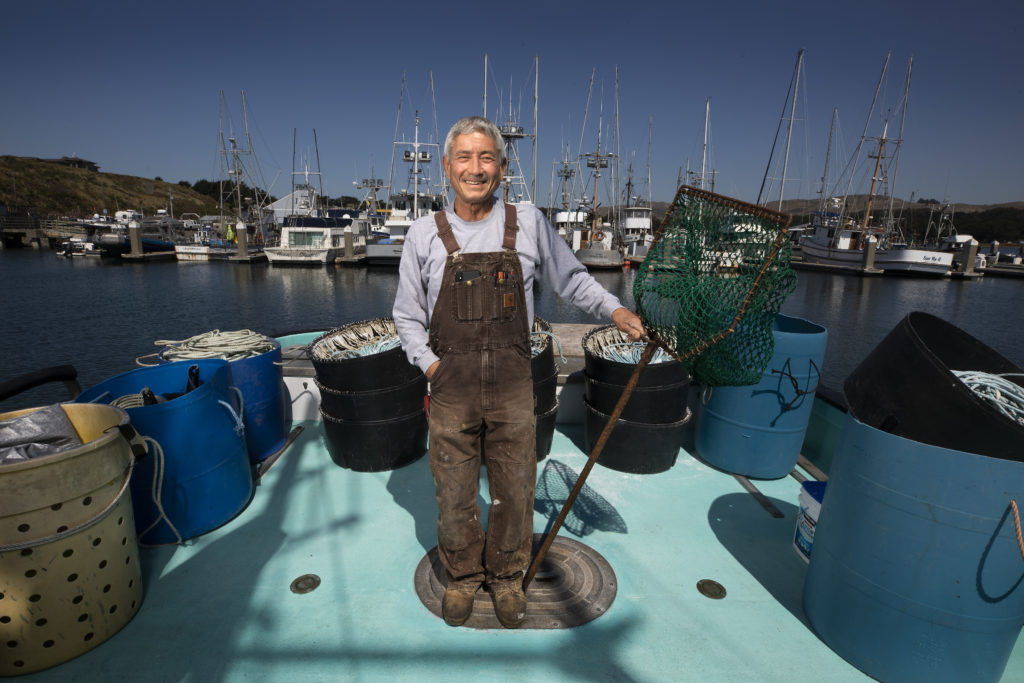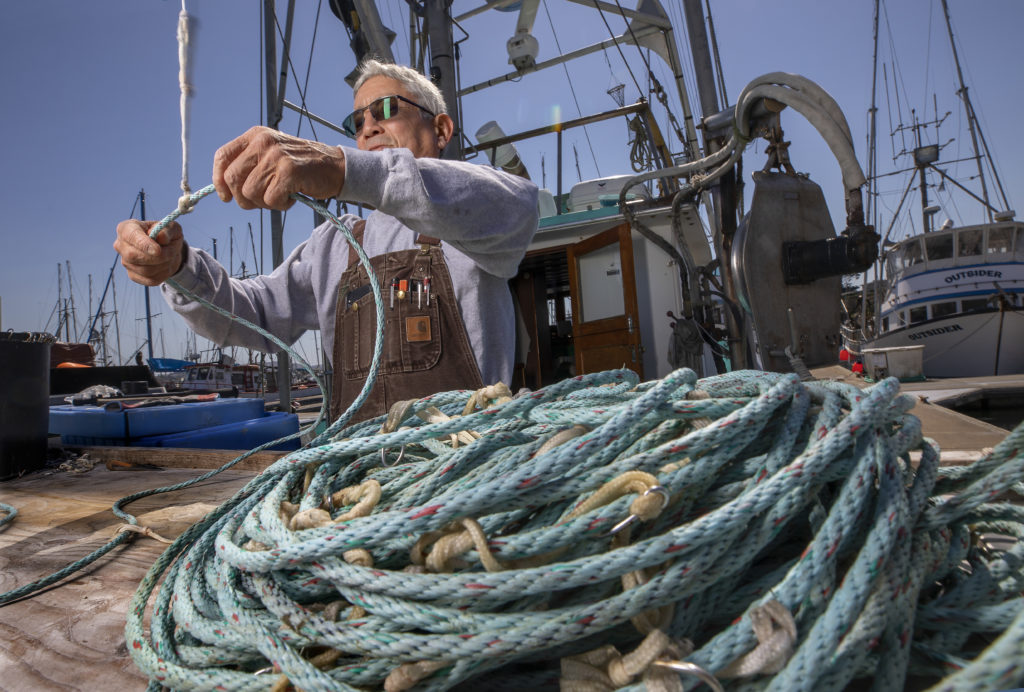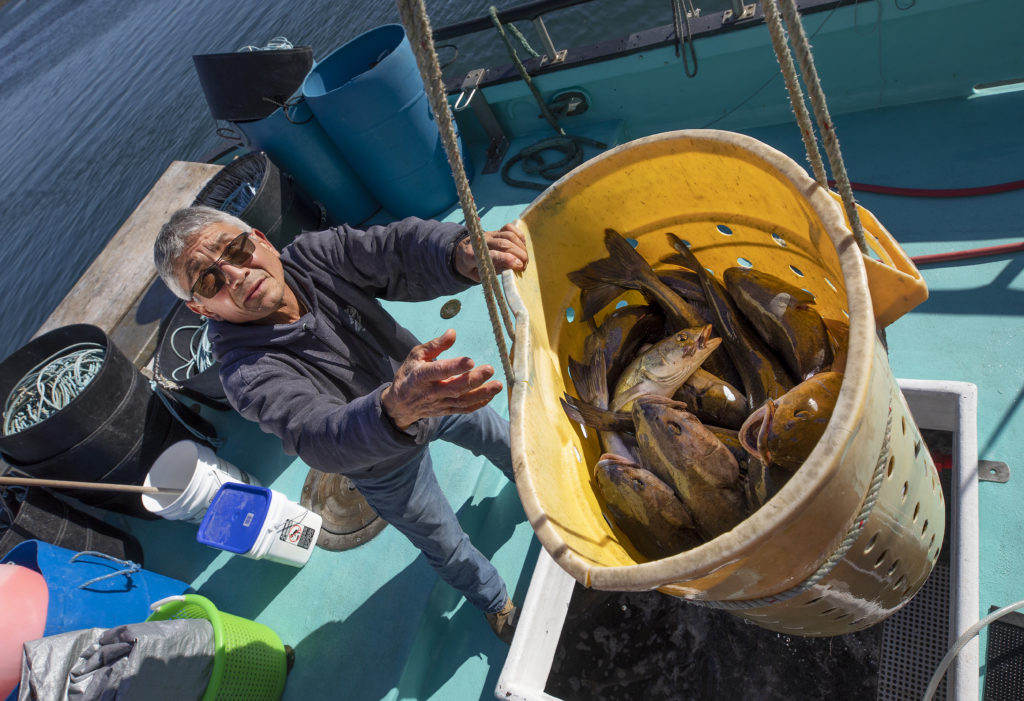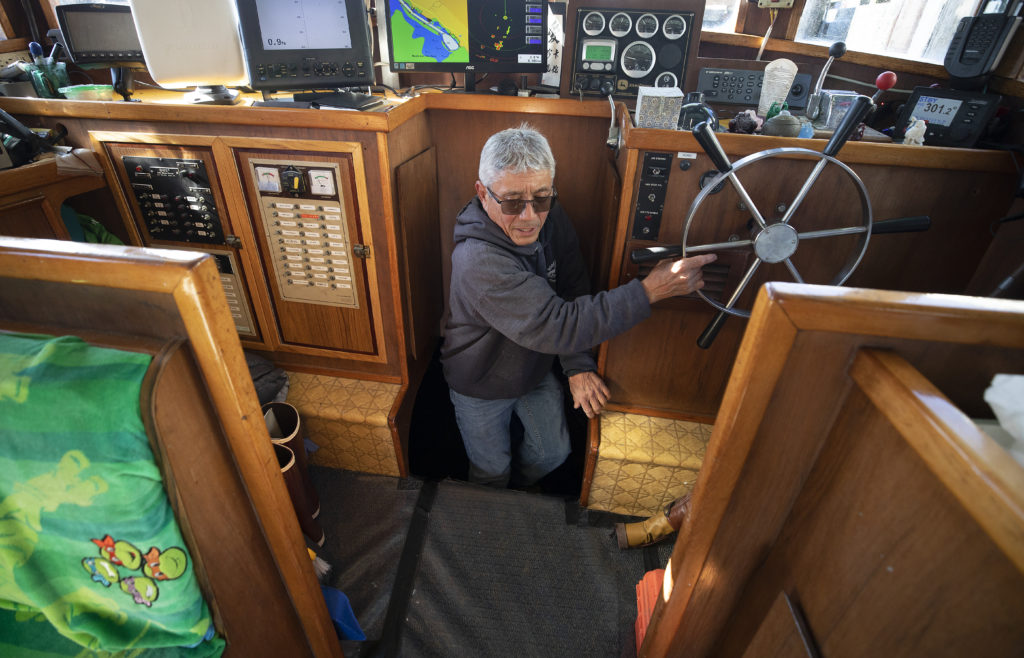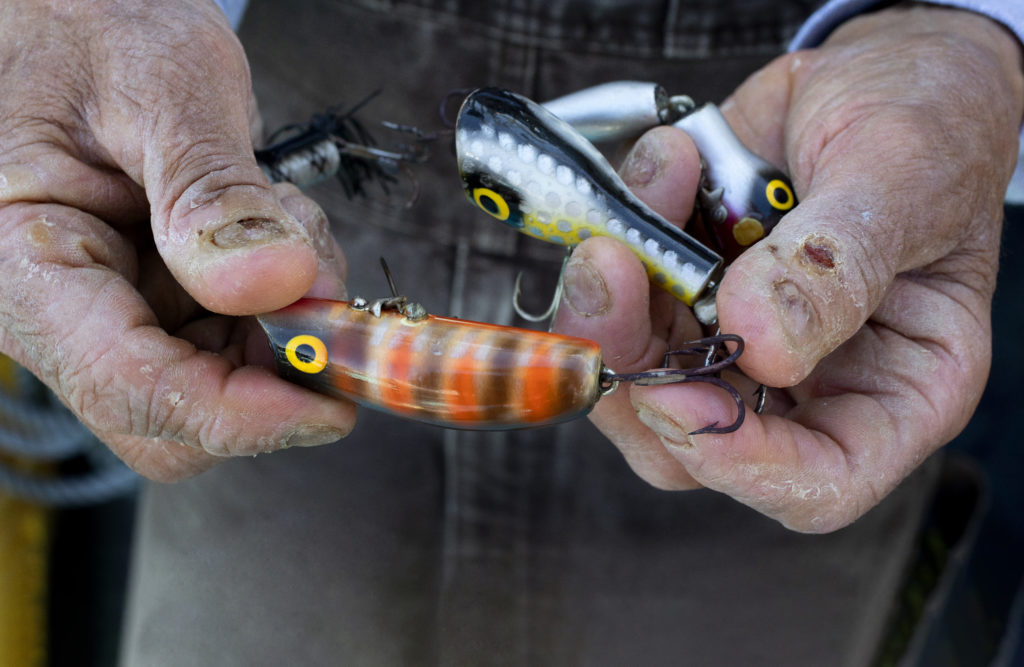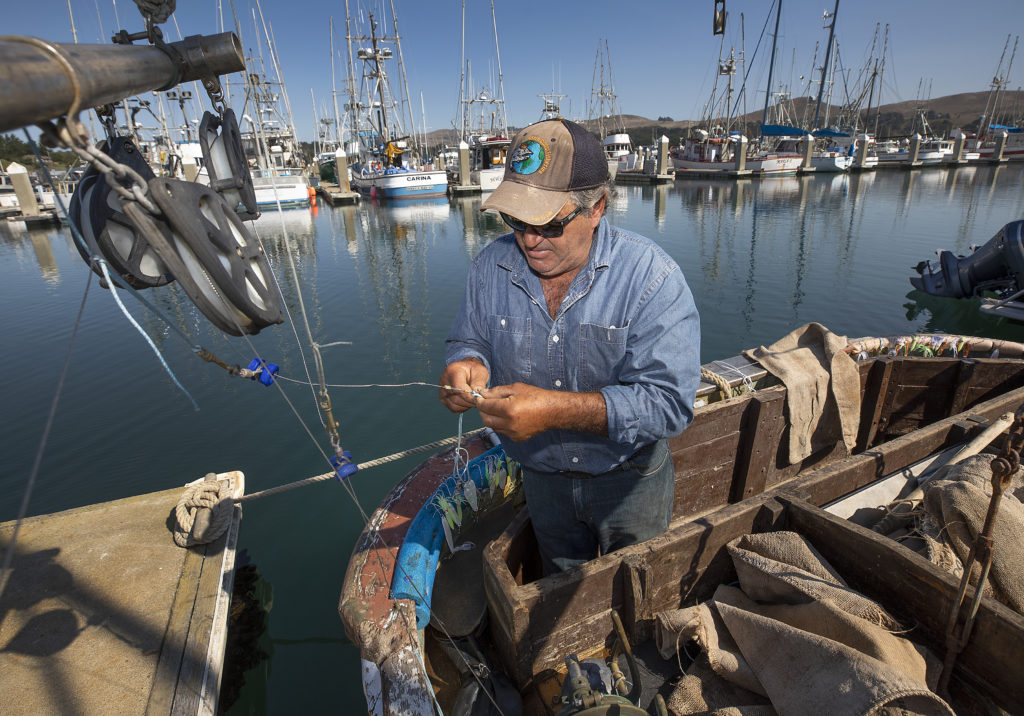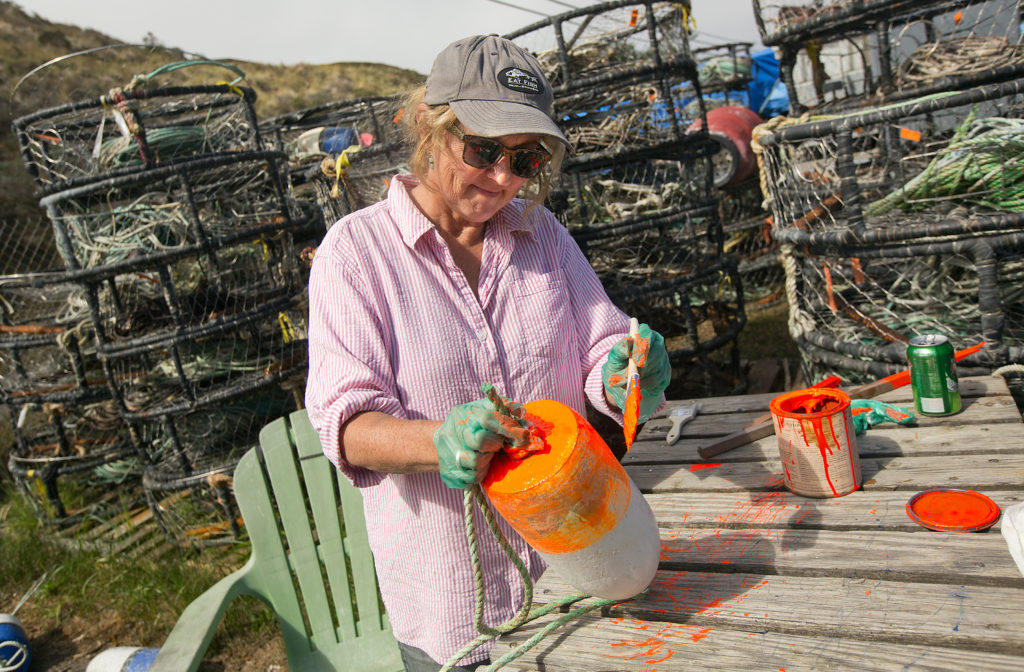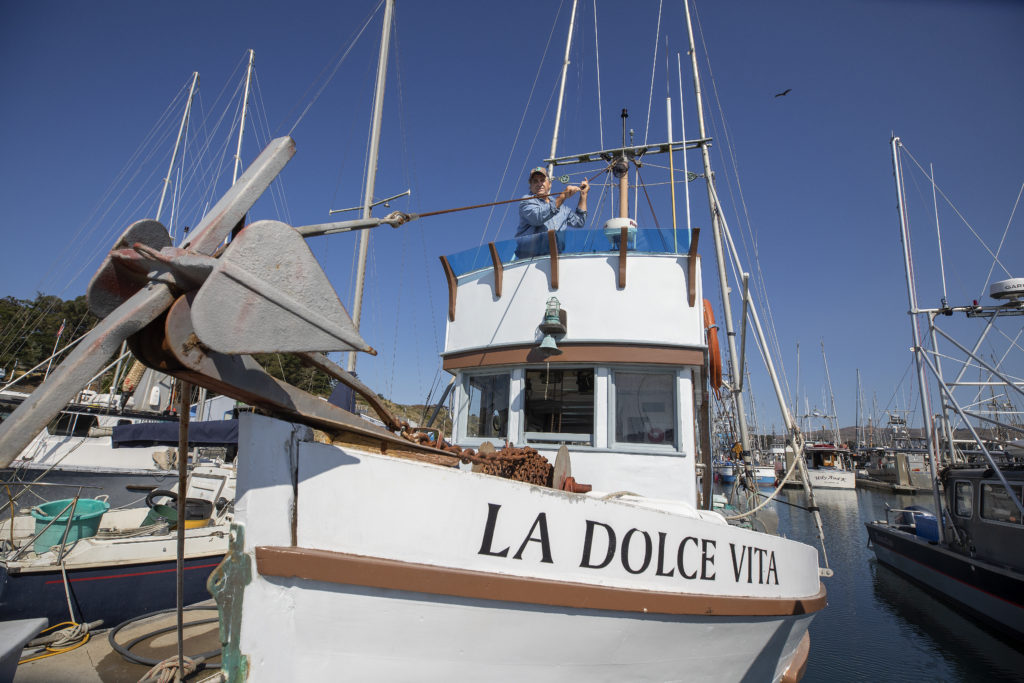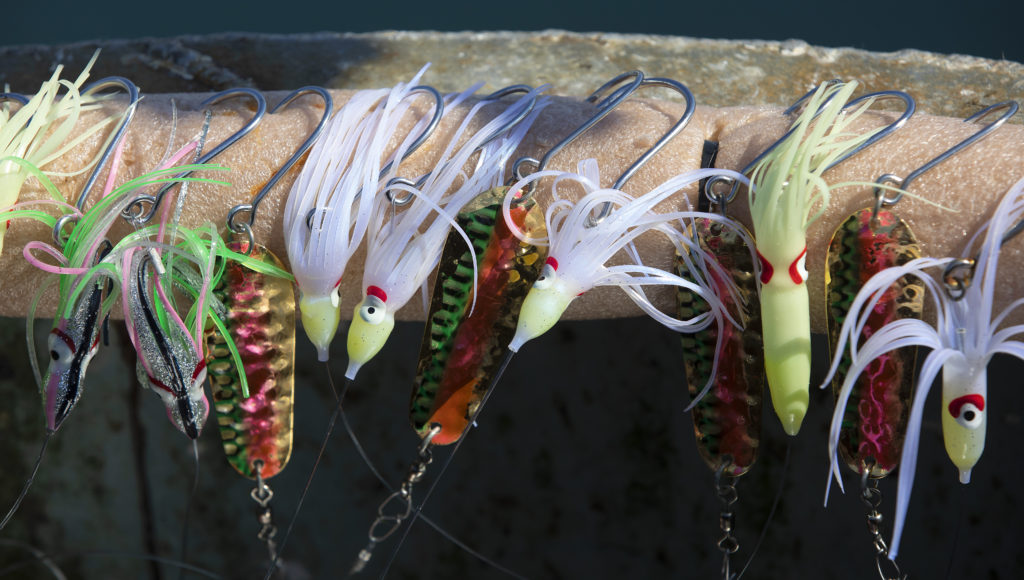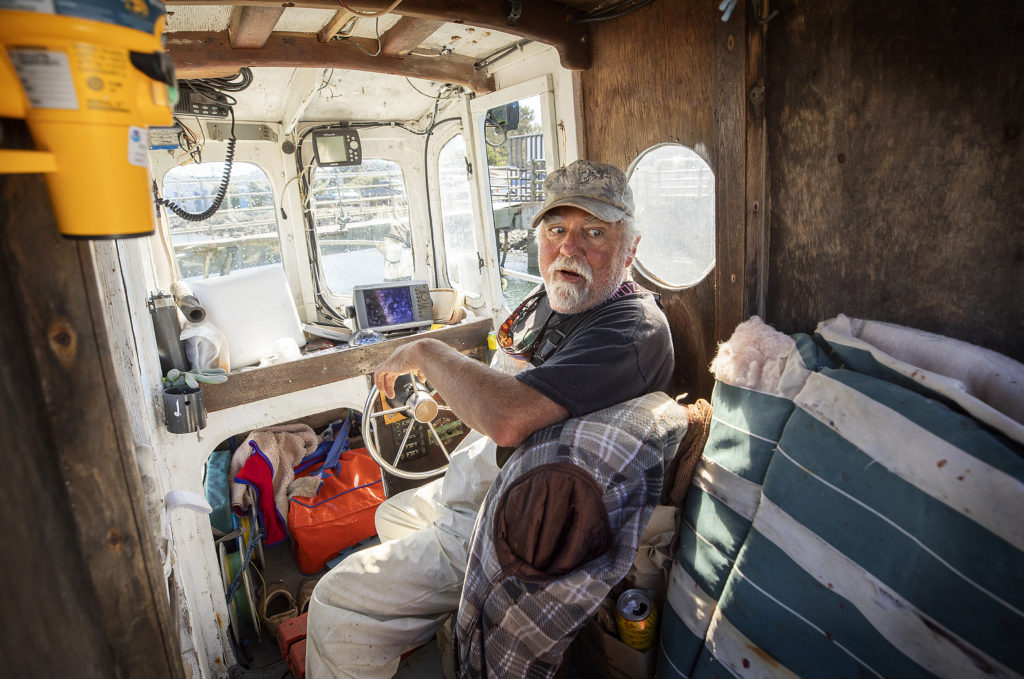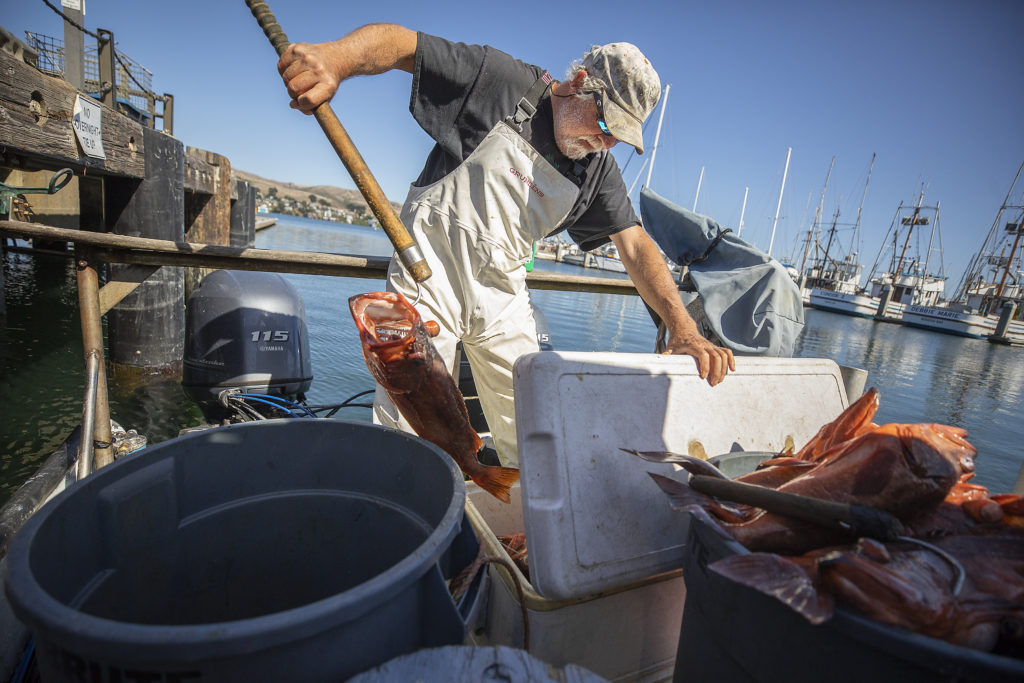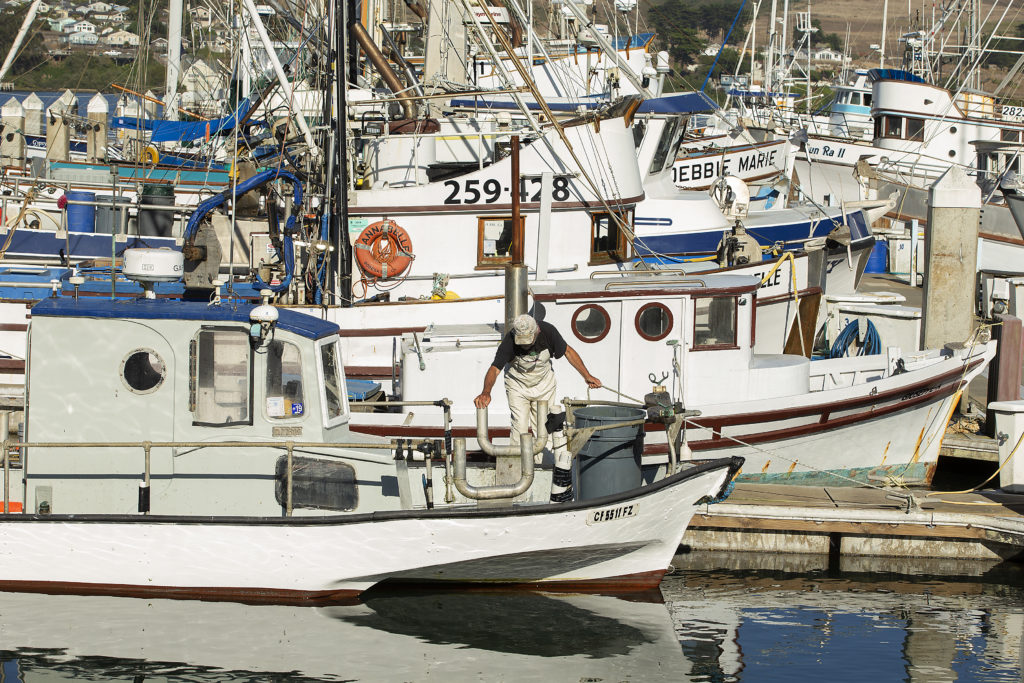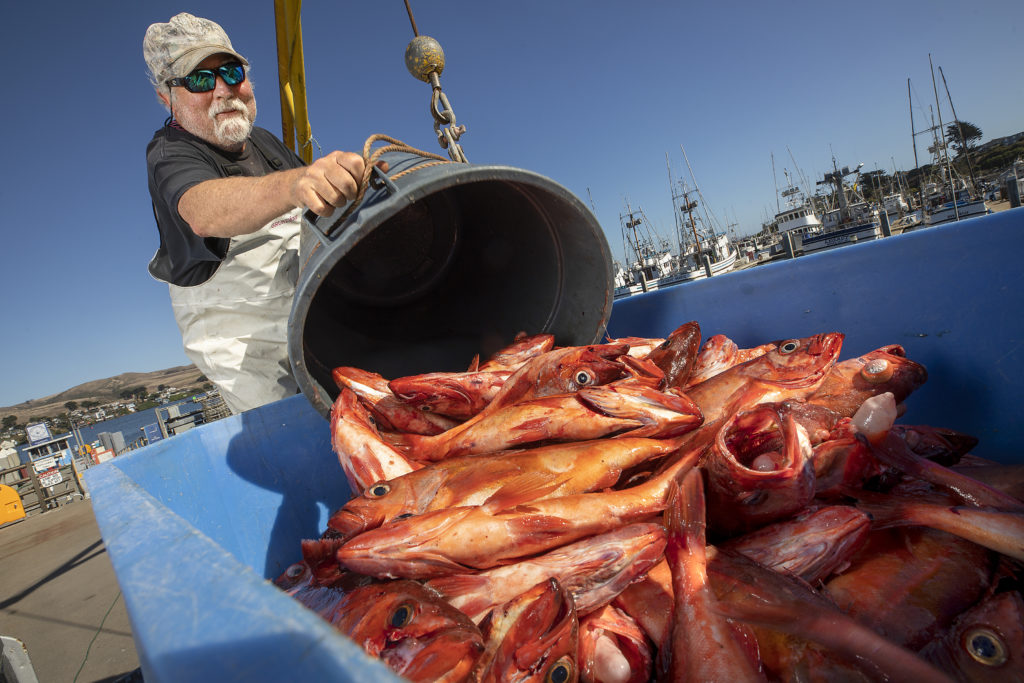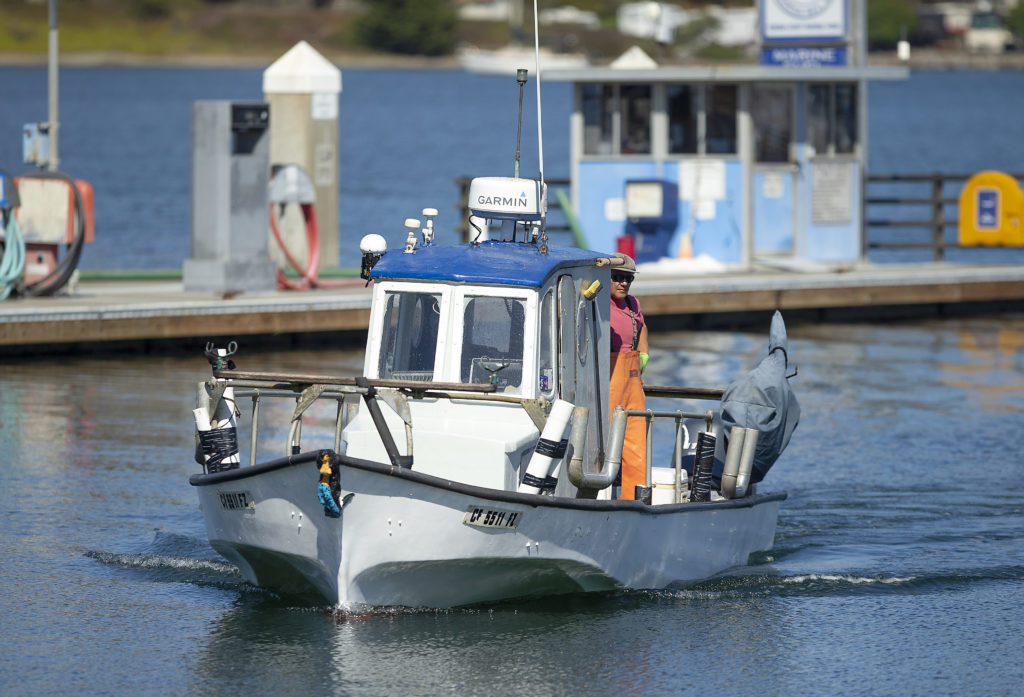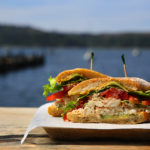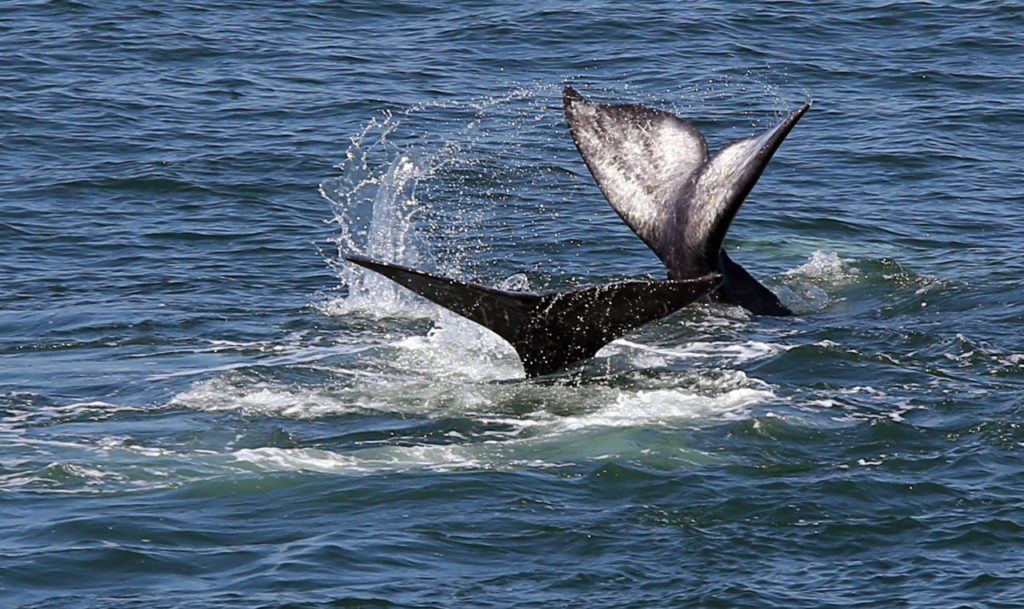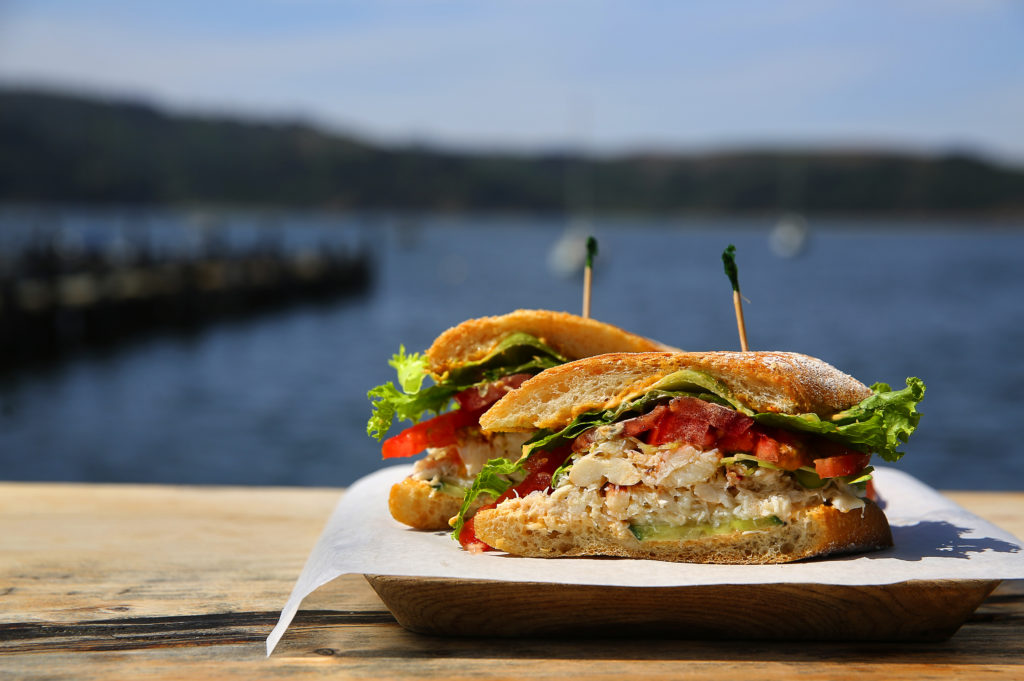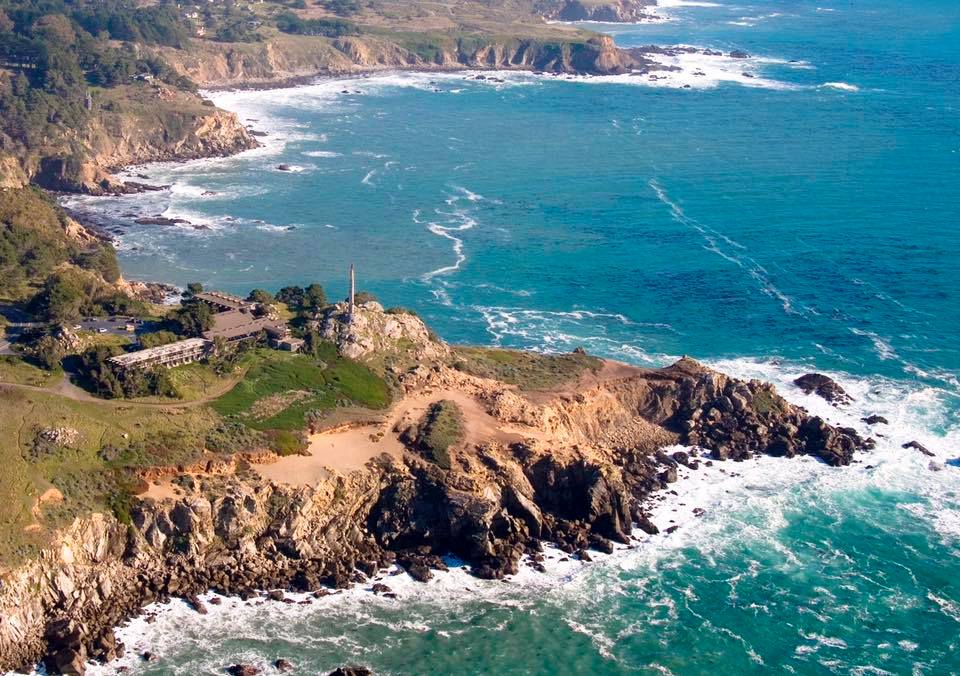Bodega Bay
A fisherman’s hands reveal something of the life at sea — the chafed, scarred skin and swollen joints a testament to the wear and tear that comes with manipulating taut lines, steel hooks, wire crab traps, and a thrashing harvest in harsh conditions. In the creases are smears of paint and grease, signs of the constant upkeep needed to keep their vessels afloat and moving.
Their bank records would divulge a good deal more, reflecting the boom and bust cycles of their livelihood, the heavy investments in gear and permits, the losses resulting from curtailments and closures like the one that cut the past crab season short by more than two months.
Their traditions are time-honored, passed from one generation to the next. Techniques and strategies are shared within families and adapted to new rules and ocean conditions.
They rise early, spend days rolling in the swells amid all types of weather, and confront daunting risk to fill their holds when the fish are biting.
They are competitors, yet part of the same tribe, a fiercely protective one that is increasingly under threat.
The men and women of the local fleet have been sustained for most of the past century by king salmon and, ever more, by high-value Dungeness crab caught in abundance off the North Coast. Black cod, albacore, rockfish, and other species supplement their harvest.
Newcomers learn quickly to ride the waves of good and ill fortune.
But between the rising pressures of a global market, shifting environmental conditions, and new regulatory restrictions, their world has become more challenging to navigate.
Forced by the nature of their work to be radically self-reliant, they now find their fate increasingly beyond their control — their ranks shrinking as old-timers call it quits, leaving those struggling to hang on often wondering why.
This past king salmon season has been a bright spot, the best run in more than a decade — a result of drought-ending rainfall three years ago that boosted stream flows for spawning adult fish. But myriad concerns about this crab season, both environmental and economic, have furrowed brows in commercial ports up and down the North Coast.
Most alarming for the fleet is fallout from a lawsuit over crab gear that can ensnare whales. It means the seven-month season that typically begins in November could be shut down at any point. This fall, it resulted in an extraordinary move by crabbers. Led by Bodega Bay’s fleet, they persuaded the state to postpone the season opener until at least mid-December to steer clear of the high number of migrating whales that have yet to leave Bay Area fishing grounds.
Creatures of the ocean are elusive by nature, and the sea’s bounty unpredictable, so the fishing life has always been fraught with uncertainty.
But now?
“It’s a pretty hard pill to swallow when you’ve got someone telling you you can’t be on the water,” said Joe Mantua, 46, a crabber for the past 28 years. “We’re fishermen. We want to go out and fish.”
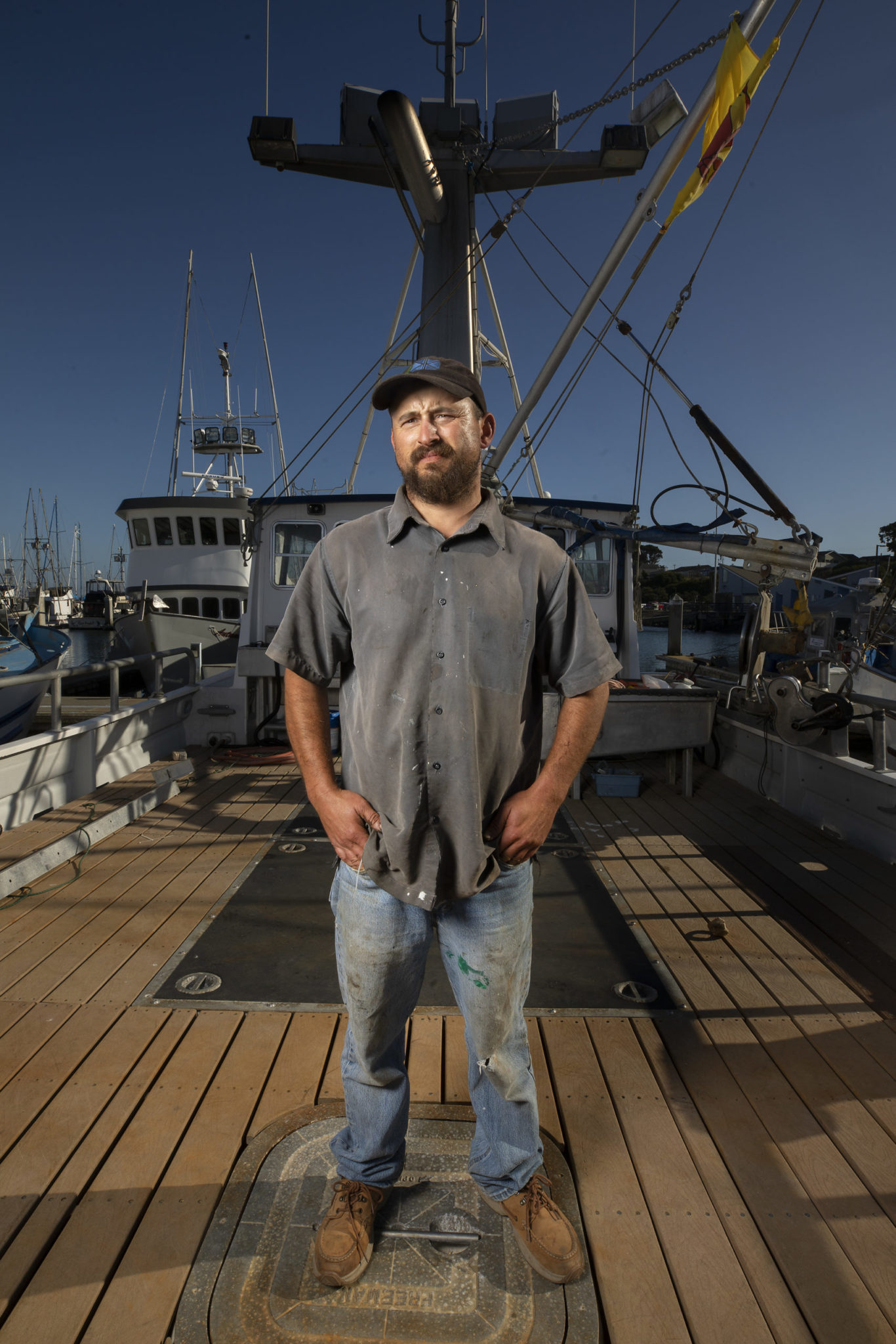
Mark Anello
There was never a time Mark Anello planned to do anything but earn his living from the ocean. He was more or less born to it.
Since his great-great-grandfather first landed fish on the coast of Sicily, five generations of men in the family have found their way to commercial fishing — even if, like Anello’s dad, Tony, they spent a couple of decades doing something like firefighting along the way.
Mark was just a tyke when his dad would pull him out of grade school to fish for herring. He had his first fishing vessel before he could drive, acquiring at age 14 a boat his father had sold to someone who later changed his mind.
Anello, 41, said he’s known he was destined for the commercial fishery “since I could work,” and spent years apprenticing as a deckhand before leading his own crews.
“I love the fishing,” he said, his clothes disheveled from a day of working dockside to repair the anchor guard on Cape Ommaney, one of two fishing vessels he now operates. “I’m good at it.”
Anello is one of those family names that everyone in Bodega Bay knows, and one of a handful of fishing families with multiple participants in the local fleet.
Besides his dad, his uncle and cousin also fish. The family’s boats are tied up side-by-side at Spud Point Marina. Across the road, his mom Carol’s prize-winning chowder draws coastal visitors to the family-run Spud Point Crab Company.
It’s no coincidence that the youngest of Mark Anello’s two fishing boats, a hulking, nearly 50-foot fiberglass craft launched three years ago, is called The Legacy.
Anello has made a name for himself as one of several hard-charging North Coast fishing captains who invested heavily in big boats and permits to match their ambitions amid a general upward trend in Dungeness crab.
They are entrepreneurs who came of age as the value of the seasonal California crab crop climbed to new heights, peaking at $95.5 million statewide in 2011-12. It has held steady at $60 million or more, except during the disastrous 2015-16 season cut short by an outbreak of algae-related domoic acid.
The Legacy can carry 33,000 pounds of crab in its massive hold and runs faster than Cape Ommaney, a wooden boat first built in 1948 with romantic, curving lines reminiscent of an earlier time. (Unmarried, Anello jokes that they’re his first and second wives.)
The Legacy’s spacious cabin has berths for the three deckhands he needs on crabbing trips to hoist the heavy iron-framed pots and manhandle the dangerously equipped crustaceans skittering about inside.
But like his fellow fishermen, he’s dependent on the alignment of nature’s cycles to succeed, and the cost of boat payments, insurance, slip fees, and the like never lets up. Standard monthly expenses for the boats run about $8,000, whether he’s landing fish or not.
Last year, the salmon season was tough and the crab season was cut short. Then he had to haul Cape Ommaney to dry dock for what he thought would be five days. It turned out to be two months. He missed much of the recent salmon season as a result, and now faces what may be the most tenuous Dungeness crab season ever — and it hasn’t even begun.
“It’s hitting people really hard,” Anello said. “We’re old. We’re in our 40s. You can’t start another career, mostly because you’re wrecked from doing this anyway.”
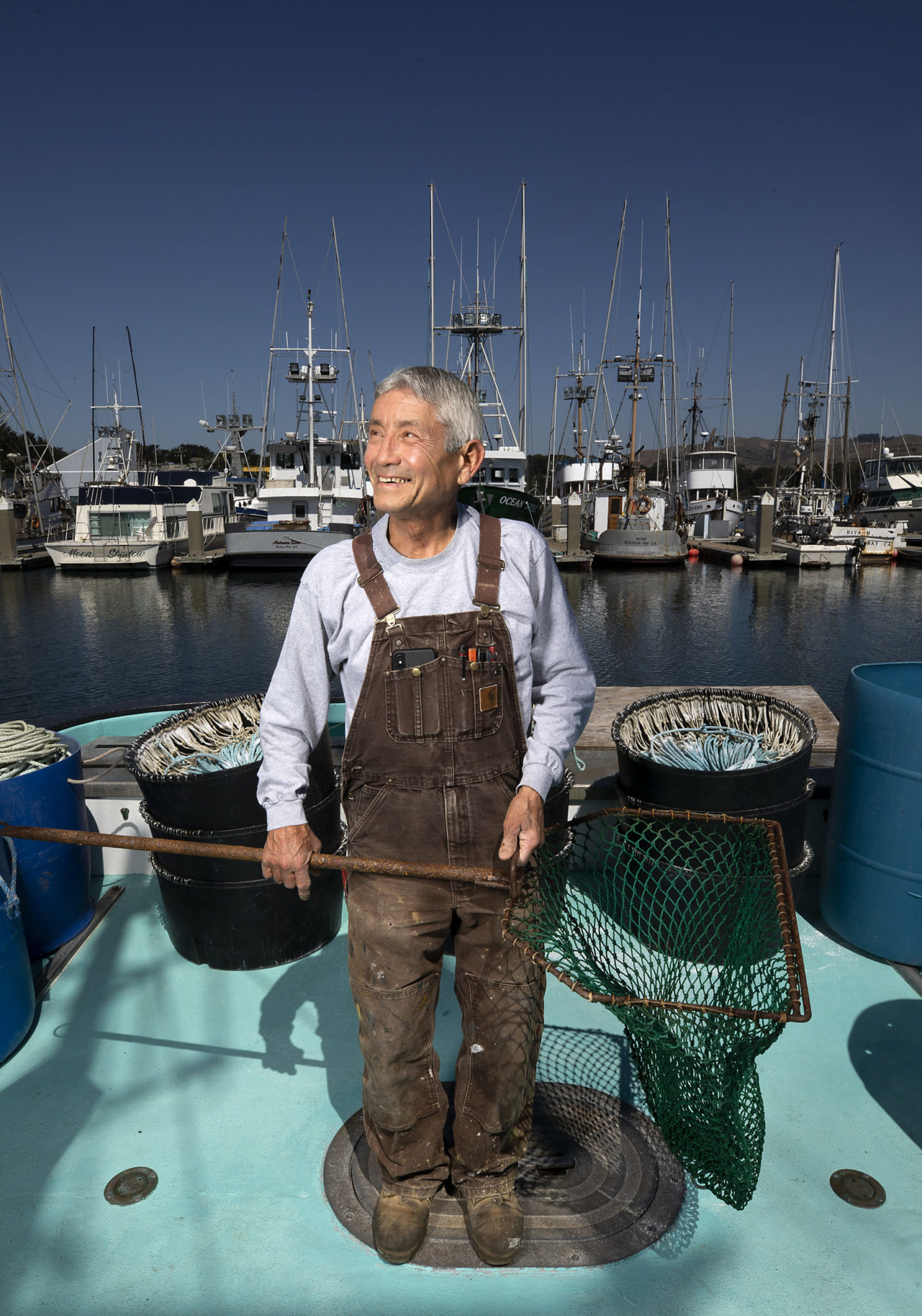
Dick Ogg
Though they’ve been little used in recent decades, Dick Ogg treasures the handmade bass plugs carved and painted by his grandfather, the man who taught Ogg to fish as a young boy during visits to Osage Nation lands in Oklahoma. His granddad, a Ponca tribal member, took special care to craft the lures, using bits of window screen and spray paint to create the appearance of tiny scales before attaching the hooks that would catch his prey.
He’d have his grandson practice casting into tin cans from set distances to develop accuracy and skill before he was allowed to try his hand in one of the many lakes in Osage territory.
Those boyhood visits for Ogg, 66, marked the beginning of a lifelong passion for fishing the California coastline, diving for abalone, and spearfishing. He dropped a line wherever he could once his dad, an Army sergeant, settled the family in the Bay Area more than half a century ago.
But Ogg, a soft-spoken, conscientious man, would spend years teaching martial arts and decades longer working his way to lead electrician at Sonoma State University before he transitioned into commercial fishing 20 years ago. Having financial stability enabled him to invest several hundred thousand dollars in expensive permits for black cod, allowing him to diversify beyond king salmon and Dungeness crab, mainstays for the North Coast. He also fishes albacore far offshore. He still had to take on debt, but “if one business slumps, I can slide over to the other.”
Ironically, Ogg doesn’t consume fish or any animal products himself, though he takes tremendous pride in the fish and crabs he and his colleagues harvest, using hooks and lines to catch finfish sustainably and crab traps that catch only crustaceans that meet size limits.
“To take a thing that’s alive and just waste the product is unacceptable to me,” Ogg said.
His consideration for the ocean has spurred him to leadership in the effort to test gear designed to prevent harm to whales that may swim into an area with crab pots and lines in the water.
He’s been instrumental, as well, in attempts to clear the ocean of abandoned gear, and represents the commercial fleet on a variety of boards.
Ogg says it’s because he wants to keep fishing and catching crab, but he also wants the fishery to continue for future generations.
“We as commercial fishermen really need to be the conservationists, and we are,” Ogg said. “We don’t want to deplete the resource, so you start thinking about just taking care of things a little bit better and making sure that it’s there for the younger generation.”
Ogg was adopted from an orphanage in Japan while his father, a pilot, was stationed there. But he came to absorb Chinese philosophy through his extensive study of martial arts as a young man. His Chinese zodiac sign is a water serpent; his western astrology sign, Pisces, the fish.
“I feel like I’m part of the ocean, I’m part of the water. I really feel very, very close to that,” Ogg said. “And so I’m most comfortable when I’m on the water or around it, and it’s very, very difficult for me to be away from it for any length of time.”
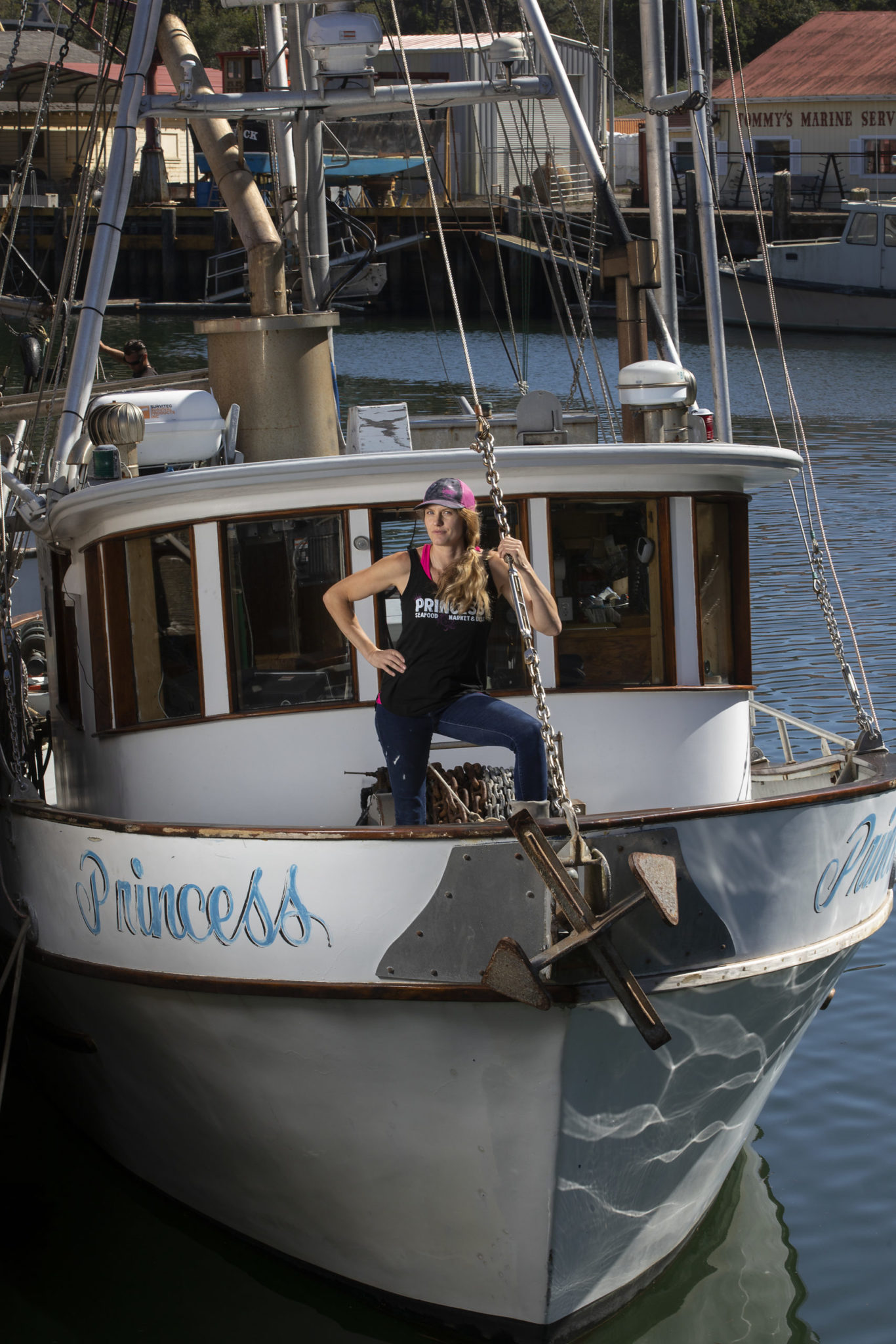
Heather Sears
Heather Sears still experiences a thrill at the memory of a singular night off the coast of southern Alaska when the ocean began to glow green with the bioluminescence of tiny marine organisms. At the same time, the northern lights brightened the sky with brilliant, streaming colors Sears could only liken to the kinds of visions that might be induced by psychedelic drugs. “It was the most spectacular thing I’ve ever seen in my life,” Sears, 39, says now. “The whole sky just lit up like some kind of acid trip. We couldn’t talk. We were just screaming.”
It was one spectacular moment that punctuated the eight times between 2006 and 2016 when Sears was forced by poor local conditions to head toward the Arctic for salmon. Those treks only reinforced her desire to stay close to home, catching fresh, sustainable seafood for North Coast customers.
The Alaska trips were necessary to keep her business afloat during years when the local salmon fishery was closed or stocks were insufficient. But they became brutal endurance tests for Sears and the shifting, all-female crew aboard her 42-foot vessel, Princess.
It takes at least 15 days to run up there along the western edge of the continent. Then the clock starts on the annual king salmon season opener, which in Alaska lasts fi veto-10 frenzied days with a single limit for the assembled fleet and hundreds of miles to search in hopes of finding enough fish to make the trip worthwhile, Sears said. Her catch in those years accounted for about 70 percent of her annual income.
The pressure and anxiety were immense, knowing she already had spent several thousand dollars on fuel and other expenses. And being in Alaska meant missing whatever minimal salmon season might be underway back home.
The exhaustion is profound when the fish are biting. The work is demanding: unhooking the fish one-by-one, stacking them for fl ash-freezing, and dropping the lines again and again.
But, at least, “You don’t feel any pain,” Sears said.
“You’re so excited that you’re getting them — that this is the time to make your money — because lots of the time you’re not making money, like most of the time.”
Sears at least knew what she was getting into. Growing up in a fishing family in Morro Bay, she was often aboard her father’s boat, fishing salmon as young as age 8.
Commercial fishing was not something she imagined for herself, but she understood it as a family pursuit. She and her parents shared an awareness of the hold that the weather and market had over their lives.
“It’s not just a job. Your life revolves around the boat maintenance, the seasons,” she said. “You learn to get into a different mentality where you think with the seasons and the ocean conditions.”
Sears remembers challenging periods for the Central Coast fishery and seeing the fleet thin out as people around them struggled.
Her own family one year came close to losing everything, including their home, but for “one amazing herring trip” that saved the day. “A lot of guys didn’t have that trip,” she recalled.
But eventually, her father found himself with a huge catch of tuna he could not sell in a saturated market. He sold his boat and got out, a devastating loss of identity for the entire family. Sears was 17.
About a year later, she dropped out of high school and headed up the coast in search of work, falling “absolutely head over heels in love” with the Mendocino Coast as she approached Fort Bragg.
She took some community college classes, but after crewing on other boats for a few years acquired her first fishing vessel at age 21 and never looked back, trading up until she acquired Princess. It’s equipped with a blast freezer that allows her long stays at sea while still supplying sashimi-grade products.
Sears’ strategy has been to sell her fish directly to the public through farmers markets and even, for a year, off the boat at the harbor. Though rocky at first, she found her niche online at Princess Seafood and last year expanded into brick and mortar with her business partner Wendy Holloway, opening Princess Seafood Market & Deli in Fort Bragg.
Sears recently invested about $130,000 in a commercial Dungeness crab permit and traps. She had one good year, confronted the shortened season earlier this year, and finished with exactly half the landings of the previous season.
She now faces the uncertainty brought on by the legal triggers affecting the crab season. It has yet to begin, and when it does, should something go wrong, authorities could close it down in an instant.
“I thought this was going to allow me to fish at home,” Sears said. “It’s scary and sad and discouraging.”
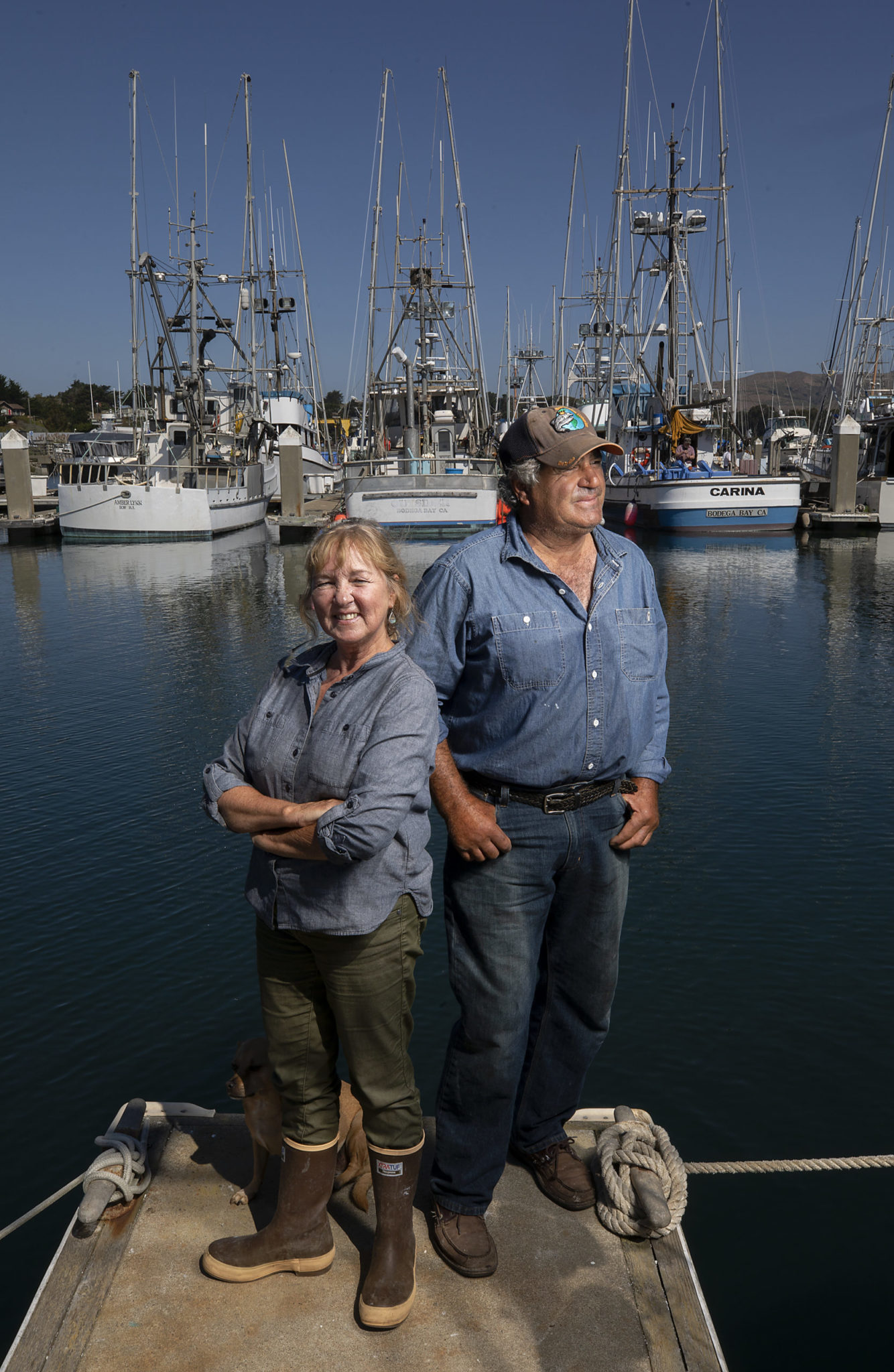
Nya and Jeff Genovese
The night before her first fishing trip, Nya Genovese didn’t sleep. Despite what had been 20 years of marriage to a veteran of the California commercial fleet, she wasn’t sure what to expect out on the open water, and the not knowing kept her awake.
A pro now after five years in the compact wheelhouse of La Dolce Vita, the 38-foot Italian boat her husband, Jeff, first crewed as a young man and later bought, Nya, 64, laughs at the memory of her fear.
“You just get right with the rhythm of the ocean,” she says, her lilting voice revealing traces of her French-Canadian roots. “You kind of become part of it.”
The quality of the light, the beauty of the wildlife, and the allure of wide-open ocean offset the hard work and long hours, she said. And they offer a different life, a different sense of time.
“You’re out there on the water, it’s like poetry,” she says. “It’s like you’re part of a song.”
But it remains a daily struggle for the pair to carve out a living on the water, at the whim of the weather and Mother Nature, as well as fishery managers. The spring crab season closure cost the couple a third of their annual income, and high winds during the last month of salmon season made for tense days.
Until the day she found herself aboard Jeff’s fishing vessel, Nya’s professional pursuits had been largely artistic. Educated to teach music in her native Quebec, she had run a music school for a time after college, until her desire to see more of the continent got the best of her and she found herself on the California coast for an extended stay by way of Mexico and Central America.
She was painting Inuit-style gourd rattles in Santa Cruz when she met Jeff, already a longtime fisherman. It was a trade he learned to embrace after knee problems during college laid to rest all hope of a Major League Baseball career.
Jeff, 63, is the grandson and great-grandson of Sicilian fishermen. His father, a Santa Clara Valley rancher who regretted missing out on life at sea, arranged work for his son on the Central Coast among other Italians who netted schooling fish the way their native countrymen had. But after several decades with the Santa Cruz fleet, the Genoveses brought La Dolce Vita to Bodega Bay for what was supposed to be a year. “We fell in love with the whole region,” Jeff said. “It was like a sanctuary. And the fishing grounds were better.”
He learned to harvest king salmon with hook and line and trap Dungeness crab with the rest of the local fleet, alternating fisheries as the seasons and the weather allowed.
Nya mostly stayed home in Grass Valley, tending to the youngest of their three boys — one they had together and two that Jeff had from a previous relationship. For several years, until it became too much, Jeff would drive home on Fridays so the couple could prepare and smoke fish for weekend farmers market sales.
But when their youngest, now 23, finished school, Nya decided the time had finally come to join her husband on the ocean, needlessly passing that first sleepless night on board only to find how well-suited she was to fishing life. She took to navigation “better than any guy,” her husband said.
With their Chihuahua mix Eddie, they’ve spent recent years fishing salmon over the summer and early fall months. They’ve recently started selling some of their catch directly from the boat to improve their margins.
“It’s been great,” Jeff said. “I’ve enjoyed salmon fishing more than ever.”
Until the early spring closure, the couple also hunted Dungeness crab in the latter part of season, which typically starts in mid-November and runs through June. For the opening months, Jeff takes a couple of sturdy deckhands for whom the long days of heaving 100pound crab traps pose less of a chore.
Though their fishing vessel has bunks below deck, the Genoveses stay during fishing weeks aboard a 38foot sailboat moored just down the dock from La Dolce Vita, making for a short commute in the mornings.
“It’s a great life,” Nya said, “but nobody knows it until you start doing it.”
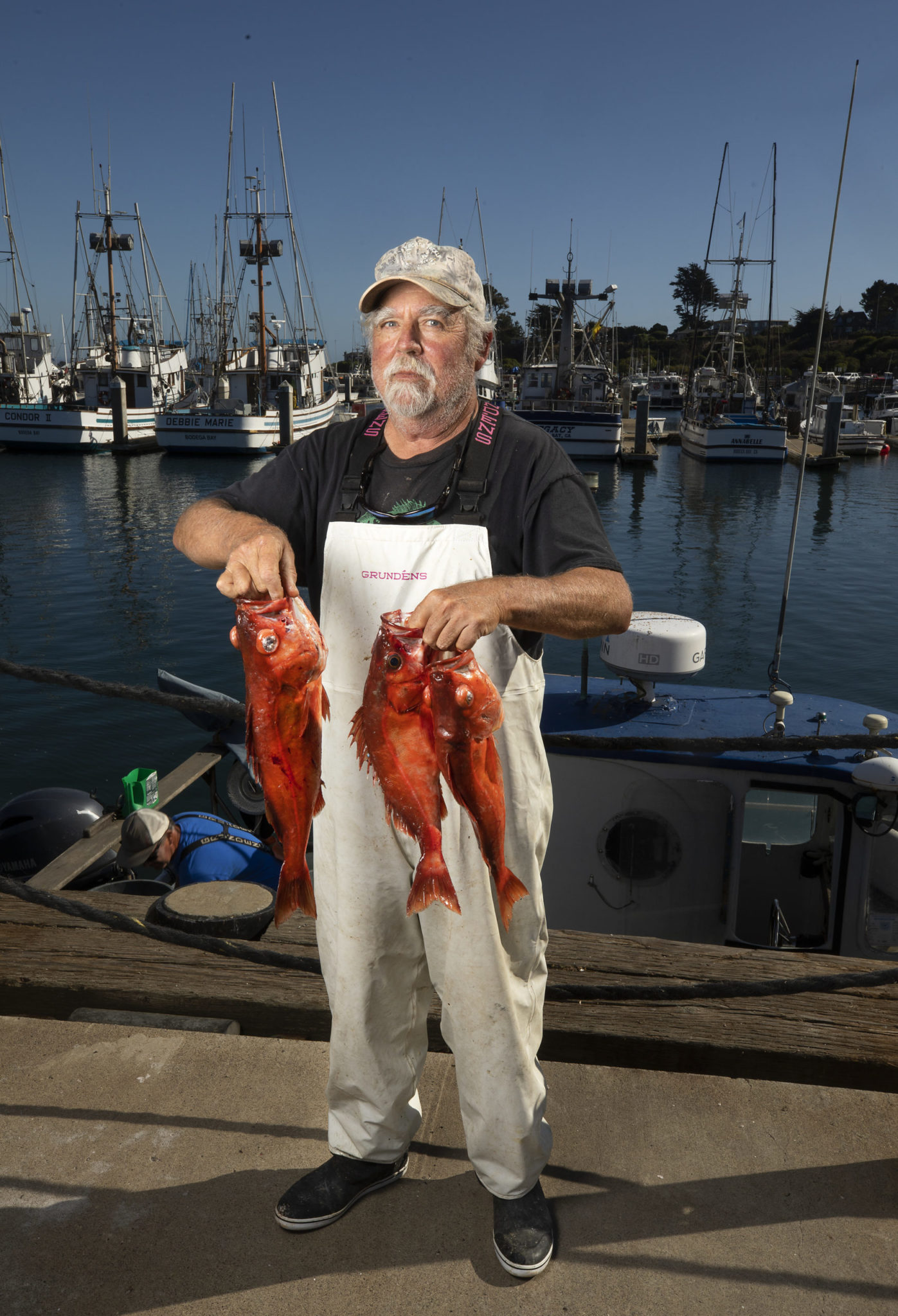
Josh Churchman
There was a time when Josh Churchman possessively guarded the coordinates for his most fruitful fishing grounds — places offshore of Point Reyes, around Cordell Bank, where he could be assured of loading his tiny boat with rockfish. That was in the days before large swaths of the region were declared off-limits.
His 40-year history of plying now-protected waters allow him more access to those waters than most fishermen enjoy. But there would be no more secrets.
A key condition of his federal permit is that he keep a satellite tracking device on his boat so fishery regulators can watch his every move. And they do.
A decade ago, Churchman, 67, ran afoul of the rules when he trespassed about a quarter-mile inside restricted waters on repeat occasions, a mistake he attributes to onboard instruments he said showed him in an allowable area. He even had a federal observer with him at the time. It’s required under his permit for two months out of each year.
Though he fought the nearly $36,000 citation for several years, he ended up $21,000 in the hole anyway.
Yet there’s little bitterness in Churchman’s voice as he recounts this tale. And although deprived of his favorite places to fish by the rockfish conservation efforts, what he mostly wants to convey is that the fish, many of their stocks depleted decades ago, are coming back.
“It’s good for people to know that the rebuilding is happening, the restrictions are working,” he said.
It’s one of many “conundrums” Churchman, a kind of crusty, hippie philosopher, is fond of citing.
“You want restrictions, but you don’t want restrictions,” he said. “It’s hard to make a living if there are too many restrictions. There are more scientists and more regulators in the industry than there are fishermen. Those are growth industries.”
Churchman came to the ocean through surfing and the good luck granted him as a rebellious 16-year-old when his parents allowed him to leave their Mill Valley home and live at the family cabin in Bolinas, provided he keep up his grades. There he surfed and fished with his buddies, and dutifully continued his education at community college and, when the time came, UC Berkeley. He commuted with his father, a professor of business ethics and management science.
The younger Churchman earned a double major in art, specializing in ceramics, and marine biology.
By then he had already taken over building the Palo, a low-profile, 24-foot fiberglass boat he still uses to hunt colorful rockfish and black cod miles off Bodega Bay. His odd little vessel and reliance on groundfish gives him a bit of an outsider status in Bodega Bay, a tight-knit salmon and crab port.
He keeps a similar vessel near home in Bolinas that he uses to fish for salmon, and, until two years ago, for Dungeness crab.
That’s when he sold his Dungeness crab permit as part of his evolving effort to “quit in time,” as he advances toward 70 and faces the growing physical toll of moving a thousand pounds of fish around after a successful day on the water.
He’s not sure what he would do if he stopped fishing, although he has already written one memoir. “The Whale that Lit the World” details his fishing exploits and encounters with whales and other “sea monsters” along with ruminations on mankind’s management of the seas.
He also has a ceramic studio in his home and has been selling yard art, mostly frog and cat figurines, at local markets and nurseries.
But he concedes fishing is in his blood, even with the risks, the dangers, the setbacks.
He loves the ocean, and “all of her moods … the power.”
“Aging gracefully, man,” Churchman said. “There’s a challenge.”



